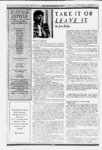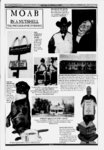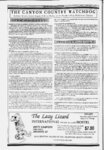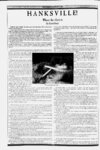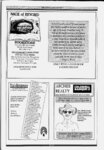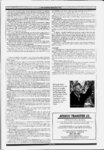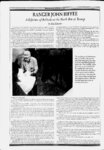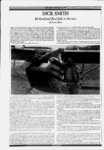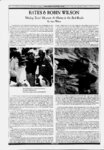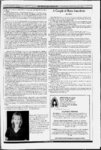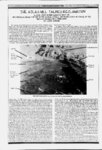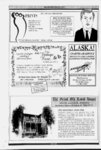| OCR Text |
Show wwywwwwrK0wcM,?xPXlCWwn?l?y;OTffR; mwfi WjvlW,rfte,i'Am,AW.mm,iWWftVi,iVjWWAiAYiyi,.V.(W1-.-- i !iW.,iV.W,WV.,V1VVAVyWMV.,JAV.iV.Vi:.V.V..,.vA6,iV.si TJjE. ATLA5 MILL TAUNl(?5 RJLCLAMATWl W CtnkftJLSt) A CASL 6TUPY N BUREAUCRATIC DK7CY OR REALLY INTEND JO PUT (JLORQL 0RWELL AhlD TZAhlZ liAfliA N CGUMSthOti?. NUCLEAR RE?1-AT0R- Y &Y LANCE Clfel6TE-- Well, students of Orwellian bureaucratic reasoning ("slavery is freedom, war is peace") now have a fine example in the final Technical Evaluation Report (TER) published March 7, 1997, by the Nuclear Regulatory Commission (NRC). Basically, the TER provides the predicted answer to the question, "Can we rationalize that capping the Atlas tailings in place would meet NRC reclamation regulations?" The answer in the TER is "yes " We are not surprised. A strenuous exercise in bureaucratic logic was required to produce this answer. The Atlas tailings ate is a textbook example of the reverse of the major 1990 NRC tailings reclamation criteria. It took a lot of bureaucratic obfuscation to make the case that capping the pile will meet those criteria. The structure used to achieve this was to fragment the tailings reclamation project into a swarm of often arcane technical issues or questions. In the Draft TER, these issues were declared "open" (unresolved) or "closed," which means the NRC thinks it's got enough information to make a CUARE Cf TE (lack of) information at the time. In August, 1990 the NRC finally adopted uranium mill tailings reclamation standards incorporating the experience the DOE had reclaiming 28 Type I tailings sites. The ideal tailings reclamation is (1) below grade (2) away from population (3) in a seismically stable site (4) isolated from groundwater and air for at least 200 and The regulations specify preferably 1000 years without any site maintenance. maximum concentration limits for leachate into groundwater, and erosion control measures (like slope and rock armor) to prevent escape of radioactive materials into the air. The NRC asked Atlas to evaluate and revise their capping reclamation plan to meet the new regulations. Since the Atlas tailings site is a textbook example of the reverse of the major reclamation criteria, this put Atlas and the NRC into a bureaucratic bind. The political problem driving all activity since appears to be that, if the NRC ends up approving a different, more expensive reclamation plan than they originally A Arches National Park Atlas Pile Potash Road and access Lion's Park to the White Rim, Colorado River Commercial campgrounds The Nature Conservancy's Scott Mathcson Preserve. UJS.191 Alfalfa fields THE VIEW FROM ABOVE: An aerial view of the Atlas Pile and surrounding area. determination. The NRC ground away on the "open" issues until they could be declared "ebsed" in a final TER. The NRC analysis process documented in the TER seems to lie somewhere between an alternative reality and a delusional system, which local people reading the TER find maddening in its violation of common sense. To understand the different way Bill Hedden, Peter Haney, Merv Lawton, the Utah Division of Radiation Control, and almost everybody else except the NRC sees the issue, we need to review the history: In 1947, the Atomic Energy Commission established a uranium ore buying station at the site. In 1957, "uranium king" Charlie Steen's UTEX Corporation built a uranium reduction mill over the Moab Wash on the flood plain of the Colorado River to process pitchblende ore from the Mi Vida Mine, in response to US subsidy of uranium production for atomic weapons at the beginning of the "cold war" with communism. In 1960 the Atlas Corporation purchased the mill and its unlined tailings pile. In 1970 the mill was rebuilt to process vanadium ores mills shut and produce commercial uranium for atomic power. 28 down, while 13 others made this transition to commercial uranium production. In 1978 Congress passed the Uranium Mill Tailings Radiation Control Act (UMTRCA). All abandoned tailings (Type I) were to be reclaimed by the Department of Energy (DOE) at taxpayer expense, under the supervision of the new Nuclear Regulatory Commission (NRC). All operating uranium mills (Type II) were required to do an Environmental Impact Statement (EIS) to evaluate alternative reclamation plans, get a reclamation plan approved by the NRC, and post a bond sufficient to cany out the reclamation when the mill closes. Atlas evaluated capping the pile in place versus moving it to nine alternative sites. The capping plan involved covering the pile with Mancos Shale and then a layer of gravel. At the time, nobody had attempted to reclaim a tailings pile, and no criteria for reclamation had been adopted by the NRC Atlas concluded it would cost $3.6 million to cap the pile in place, and $18J million to move it by truck to the nearest alternative site (7 Mile Canyon), in reclamation plan, and 1977 dollars. In 1982, the NRC approved the capping-in-plac- e This in was estimated done cost. for the good faith given the Atlas posted a bond AEC-supplyi- ng approved in 1982, they have no legal choice than to demand Atlas increase their bond to cover 45 of all costs. This is unfair to Atlas, and probably illegal, since it represents applying regulatory liabilities backwards in time against a fully compliant private company. Atlas has made clear that the company will declare bankruptcy if confronted with such a demand, whereupon the NRC will be stuck with an unreclaimed tailings pile which has no "licensee" (owner), and obliged to try to recover funds from the defunct licensee (Atlas) to reclaim it. This fruitless effort would occupy years in court, enriching lawyers at taxpayer and Atlas shareholder expense while the pile sits there leaking into the Colorado River. And significant leaking is going on, contrary to the claims in the DTER and DEIS issued in the fall of 1995. The State of Utah has since taken proper water samples evaluated by a certified laboratory, finding 10 contaminants in excess of Ground Water Quality Standards (GWQS): was 30 times over health criteria in surface water from seeps on the riverbank; nitrate nitrate 13, chloride 29, manganese 67.5, oxides 2.9 and 12.9, 1.4 times over GWQS. The 3.5, sulfate 18.1, 34.8, and Colorado River water samples found elevated downstream concentrations for ammonia (as N), manganese (342 higher), molybdenum (488 higher), and nitrate nitrite (as N, 139 higher), with ammonia concentrations exceeding surface water quality standards. Ammonia was used as a reagent in the uranium milling process, and in tailings effluent reaches 2,400 mg1 concentrations. The NRC has sole authority over radionudeides, so the state could not test for these. Monitoring wells show alpha radiation levels up to 5,600 picoCuriesliter in groundwater, versus 33 pCi1 background. The state estimates it will take at least 40 years for leaching from the pile to decline to GWQS limits if the pile is capped in place. And how does the TER deal with the state water contamination information? On "Staff further concludes that the concern of contamination extent on page 4, adjacent properties has minimal relevance to the review of the proposed plan for onsite surface reclamation of the tailings. The contamination extent does have a large STHIRTY non-radiolo- gic 5-1- |

